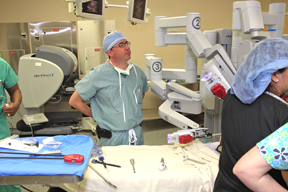Robot-assisted heart surgery sounds like something from a science-fiction movie. But in real life, a UAB cardiac surgeon is using the revolutionary, robot-based da Vinci Surgical System to perform minimally invasive mitral valve repairs and replacements that enable patients to recover in days instead of weeks.
 |
| Cardiac surgeon Chris Akins is one of the foremost authorities on the robot-based da Vinci Surgical System. |
UAB is one of only a handful of hospitals in the United States that regularly performs robot-assisted heart surgery, which also can be used for coronary anastomosis during cardiac revasularization.
Akins joined the UAB Division of Cardiothoracic Surgery in January and is one of the foremost authorities on the da Vinci system. He has been performing the procedure since 2001 and has completed more than 300 surgeries with the machine.
With robotic cardiac surgery, the surgeon uses the da Vinci computer console, which provides 3D, high-definition camera images of the surgical field and exact control of the robotic arms of the machine. Every move of the machine is a move made by the surgeon, aided by miniaturized wristed instruments maneuvering in precise, seamless movements that mimic the dexterity of the human hand and wrist.
Robotic assistance enables Akins to repair mitral heart valves with small incisions, unlike the traditional open-heart surgery. The pairing of a state-of-the-art robotic surgical technology and expertise of the cardiac surgeon translates to the most advanced minimally invasive cardiac surgery available today.
Many advantages
One out of every 10 people has leaking valves. A mitral valve repair is performed through a few small incisions on the right side of the chest, rather than opening the entire chest cavity. The minimally invasive procedure means the patient is feeling better within days instead of weeks.
Other advantages include minimal blood loss, less scarring less pain. The delicate touch of the machine also reduces disruption to other organs and tissues near the heart.
“When you tell a patient that they need heart surgery, they are immediately afraid of the incision,” Akins says. “But then when you tell them you can perform the surgery robotically, they are very happy. The true fear of heart surgery is the long incision. It’s the scarlet letter of heart surgery. But with robot-assisted heart surgery, nobody has to know you’ve had surgery at all.
“I love seeing my patient’s face light up when I tell them they won’t have to be cut open.”
Robot-assisted heart surgery is a viable option for many people in need of mitral valve repair and other complex cardiac surgery. To find out how the da Vinci surgical system can help you, contact UAB HealthFinder at 934-9999 or call 1-800-UAB-8816 to make an appointment with Akins.